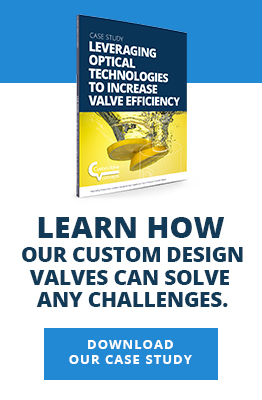How Kates Manages High-pressure Drops and Cavitation
Custom Valve Concepts Kates Flow Rate Control Valves are designed to perform under a wide range of applications, conditions, and pressure variations. Their design offers a unique solution to high-pressure drops and cavitation situations, allowing them to withstand large pressure drops, resulting in less wear and tear, enhanced durability, and accurate flow control.
Custom Valve Concepts Kates Flow Rate Control Valves are used in the aerospace, automotive medical, petroleum, chemical, power generation, renewable energy, and wastewater treatment industries to name a few, chances are, we’ve provided Kates Valves to a company in your field, too.
How Do Kates Valves Withstand Large Pressure Drops Without Suffering Damage?
The Kates controller is designed to maintain a steady flow rate regardless of pressure variations upstream or downstream. In many situations, our valves need to withstand extremely high pressures. In 2500lb ANSI rated applications, our valves will control accurately with pressure drops anywhere between 20-6200 psi. and still maintain the flow to within 1-1/2% of setting.
Basic physics tells us that if you control the pressure drop across a known orifice for a known fluid, you will control flow rate. With the Kates controller, we require a minimum “threshold pressure” of 10 psi. This differential pressure gives us enough to control the flow across our metered orifice. This means that if we had several thousand pounds of pressure at the inlet of our controller, we may have to absorb that entire amount across our exit ports in an effort to control flow accurately.
Our exit ports, also known as the Valve Tube, are cylindrical – flowing from the outside of the tube inward. There are three round ports on the tube spaced equally around the cylinder creating three equal streams meeting in the center of the exit port. While sometimes extremely turbulent for a very short distance, these high-velocity streams collide with each other in the center of the cylinder thus canceling the forces of one another.
If cavitation were to occur, it would take place in the center of the exit of this cylinder and not near any critical components. Likewise, this phenomenon also cancels noise levels. Because our adjustable orifice requires only 10 psi to function, there are no hydrodynamic forces and the adjustment can be easily made at high pressures.
What is Cavitation and Why Does It Matter?
Cavitation is the collapse of vapor bubbles. This common issue occurs if a liquid medium’s upstream pressure quickly drops below its vapor pressure as it flows in the valve. The vapor bubbles then collapse as the pressure recovers after the valve’s outlet. Cavitation then ensues due to the high acceleration of fluid inside the valve. Any particulate in the liquid media, combined with cavitation, can attribute to faster wear of the valve components and damage.
Traditional control valves attempt to minimize the impact of cavitation through a few different methods:
- Material Selection - essentially, using tougher, more long-lasting materials will extend the life of the valve.
- Multi-Stage Pressure Drops – valve manufacturers will attempt to prevent cavitation conditions by designing valves that have multiple pressure drops through a single valve. Some will utilize multiple valves instead of a single valve to take the entire pressure drop. i.e. for a system that needs to drop from 1200 psi to 100 psi, one valve may take the system from 1200 psi down to 600 psi and the second valve from 600 psi to 100 psi.
- Anti-Cavitation Valves (or Trim) – these types of valves utilize both material selection and multi-stage/multi-valve pressure drops to reach optimal design for a given system.
Kates Offers Solutions
The Kates Flow Rate Valve presents a unique solution to high-pressure drops and cavitation situations. Three symmetrical outlet ports allow for the vena contracta, the point in the fluid stream where the diameter of the stream is the least to occur in the center of the fluid stream. This minimizes valve wear and noise due to cavitation.
If the cavitation is so severe that it will erode even the toughest of materials the Kates Flow Rate Valves will be trimmed within these process conditions, the flow rate will still stay constant. This is because unlike most control valves, the Kates Flow Rate Control Valve does not rely on the size or geometry of the outlet port. The valve tube and sleeve assembly will adjust its position as needed as the outlet ports wear. This gives the Kates Flow Rate Valves a significant advantage over the longevity of traditional control valves in high-pressure drop scenarios.
Find the Best Kates Flow Control Valve For Your High-Pressure Drop Application
The experts at Custom Value Concepts are here to assist you with selecting the Kates Flow Control Valve or even design a custom Kates Flow that best suits your specific application and pressure demands. That combination of quality valves, product experience, and first-class customer service is what has made Custom Valve Concepts an industry leader for decades. Our motto, “to serve our customers as we desire our suppliers to serve us,” exemplifies our commitment to quality and service.
Learn more about the latest Custom Valve Concepts product development, emerging technology, new applications, and engineering insights by subscribing to our blog or downloading our Leveraging Optical Technologies to Increase Efficiency case study.

Sign up to receive the CVC Engineering Insights in Your Inbox:
Join us on Social Media!





Learn more about Custom Valve Concepts
Blog categories
- mechanical design (7)
- General (15)
- history (1)
- quality (4)
- manufacturing (4)
- meet the team (4)
- FAQ Kates (3)
